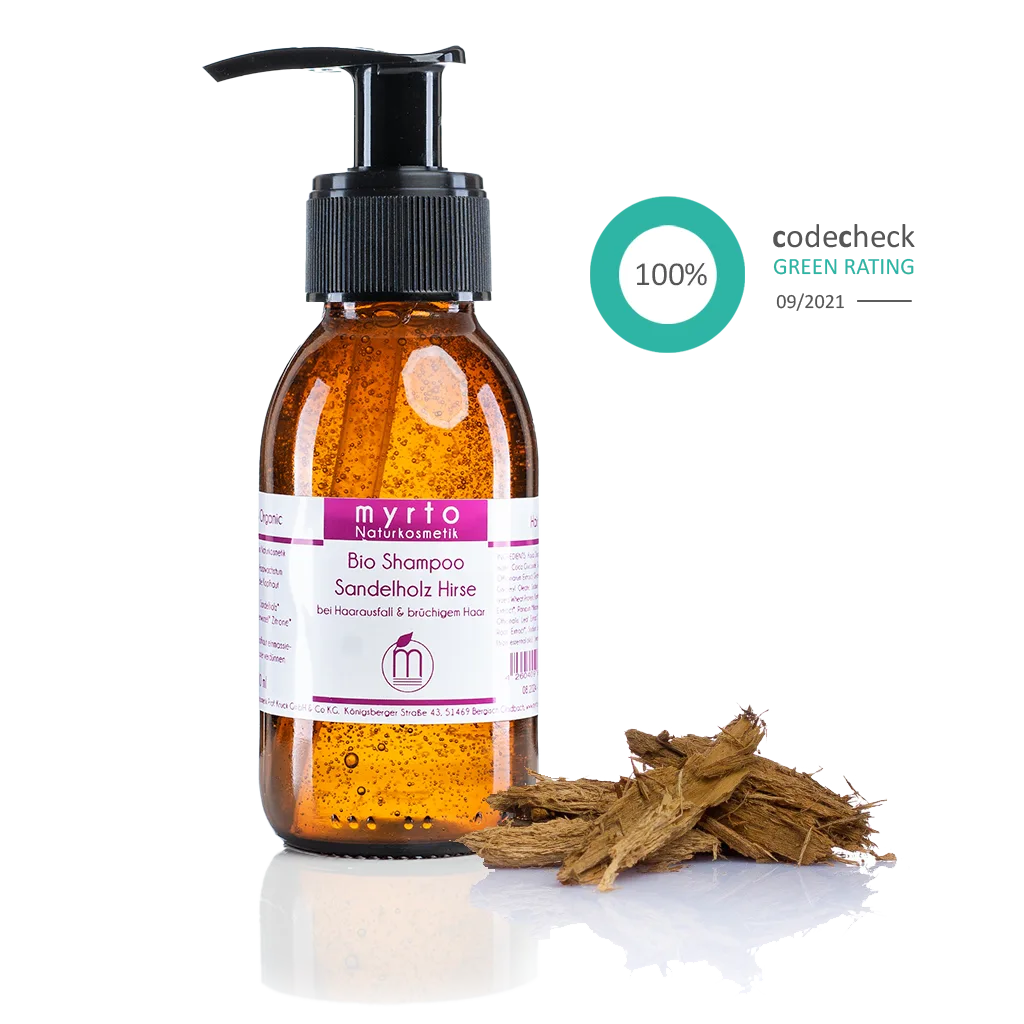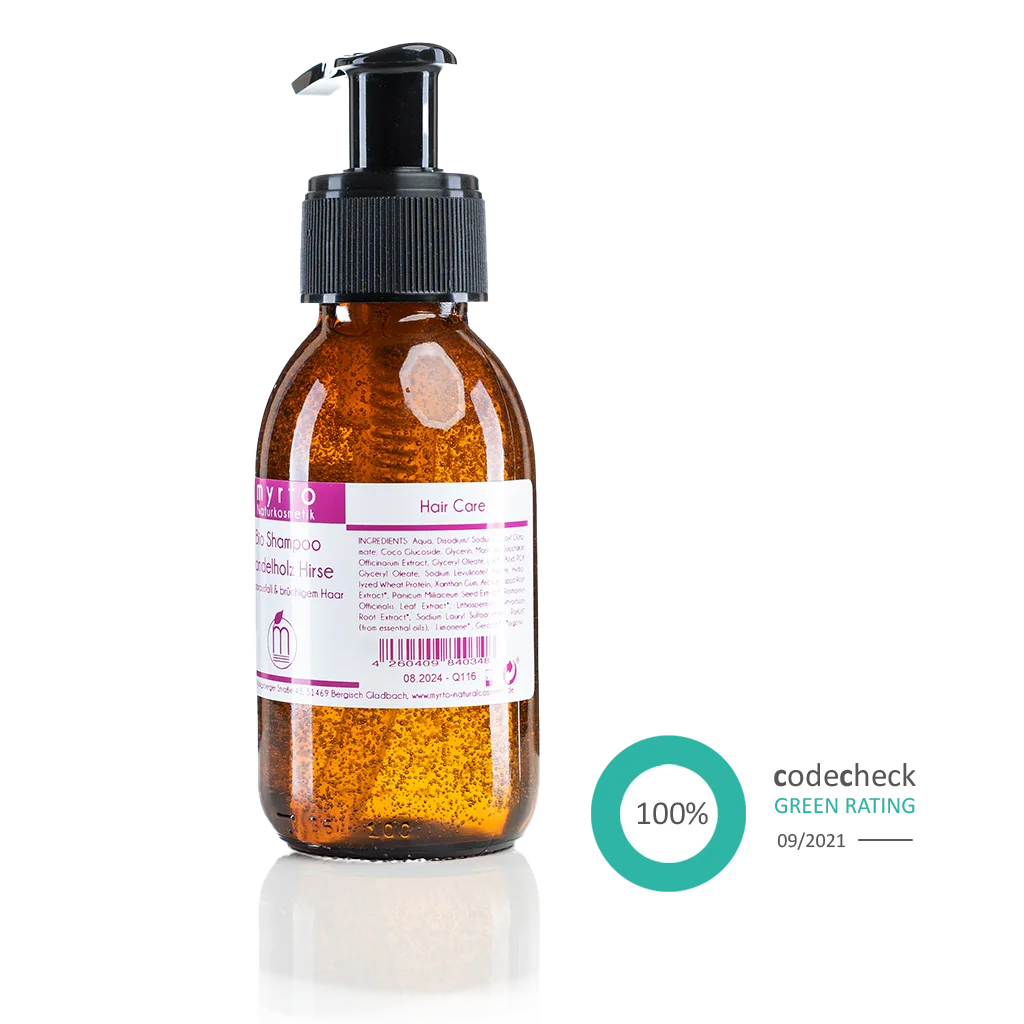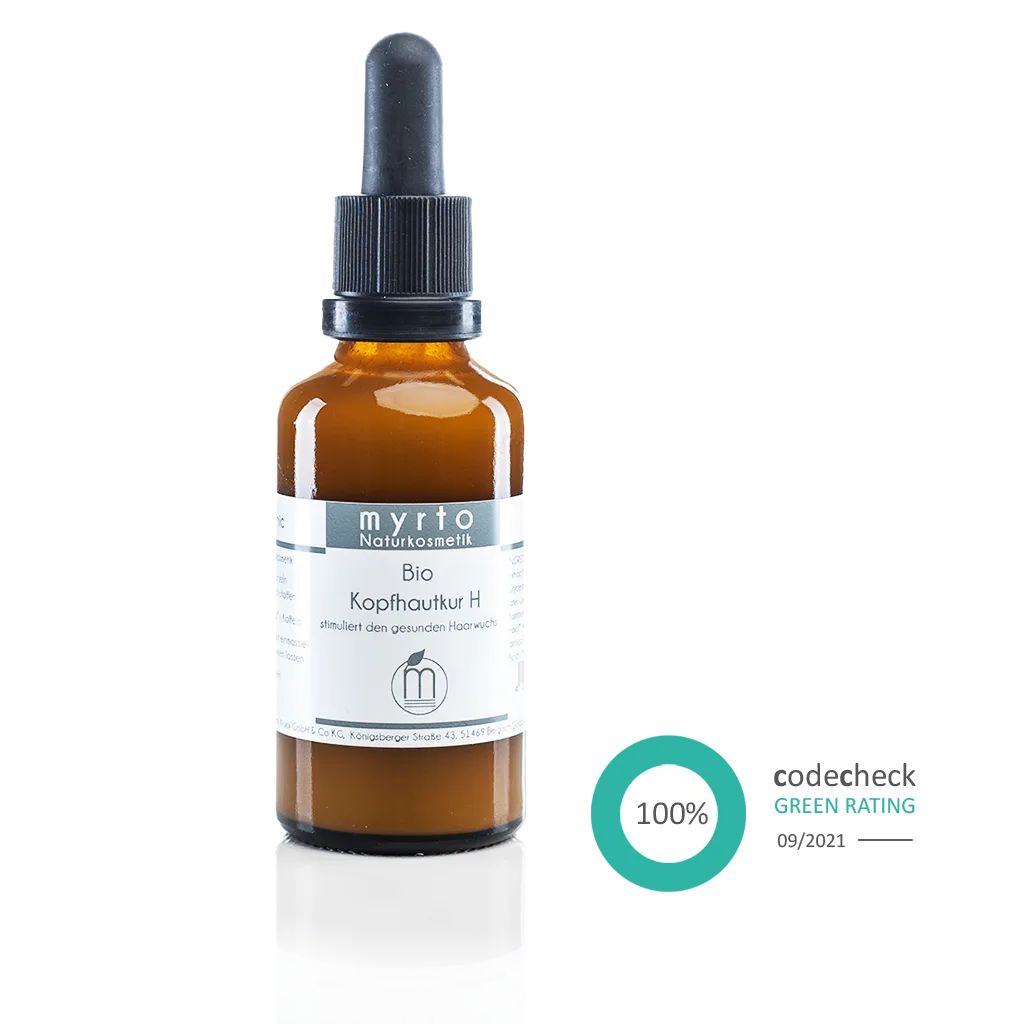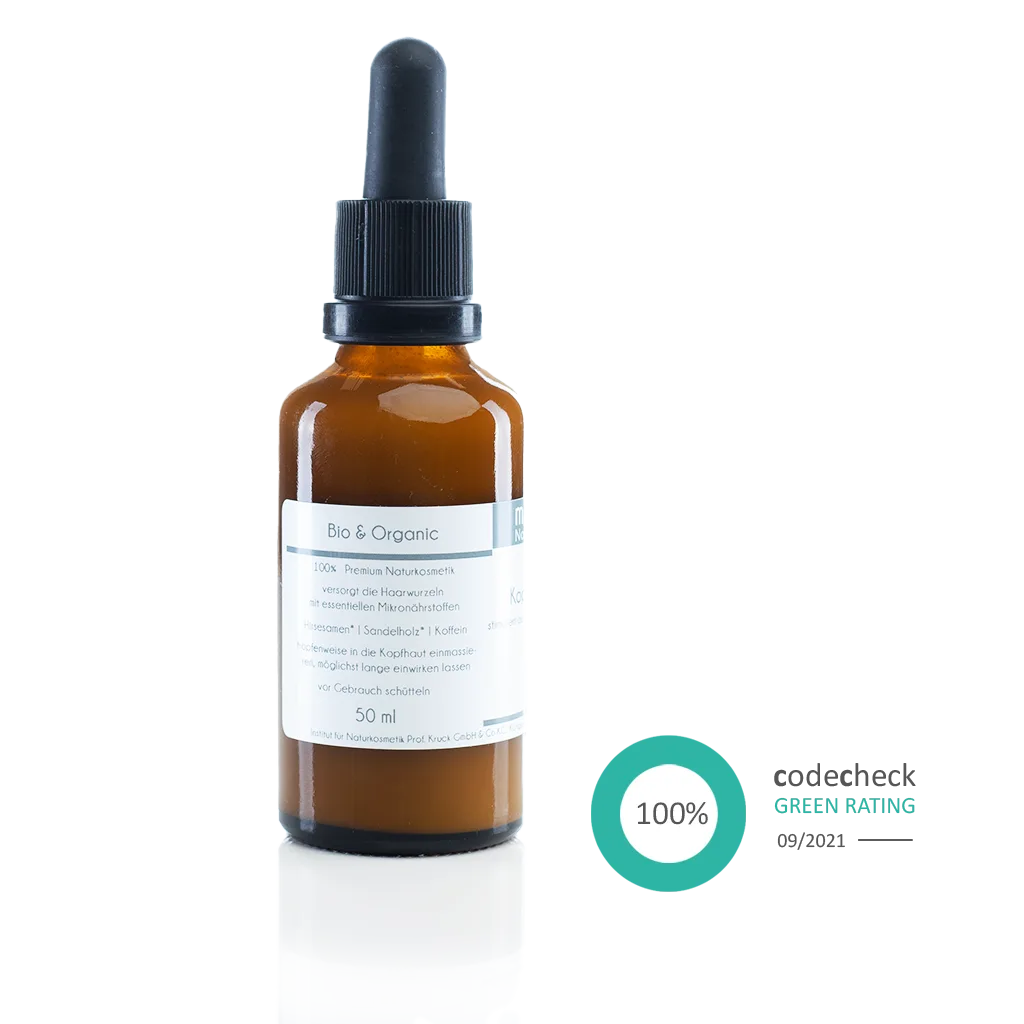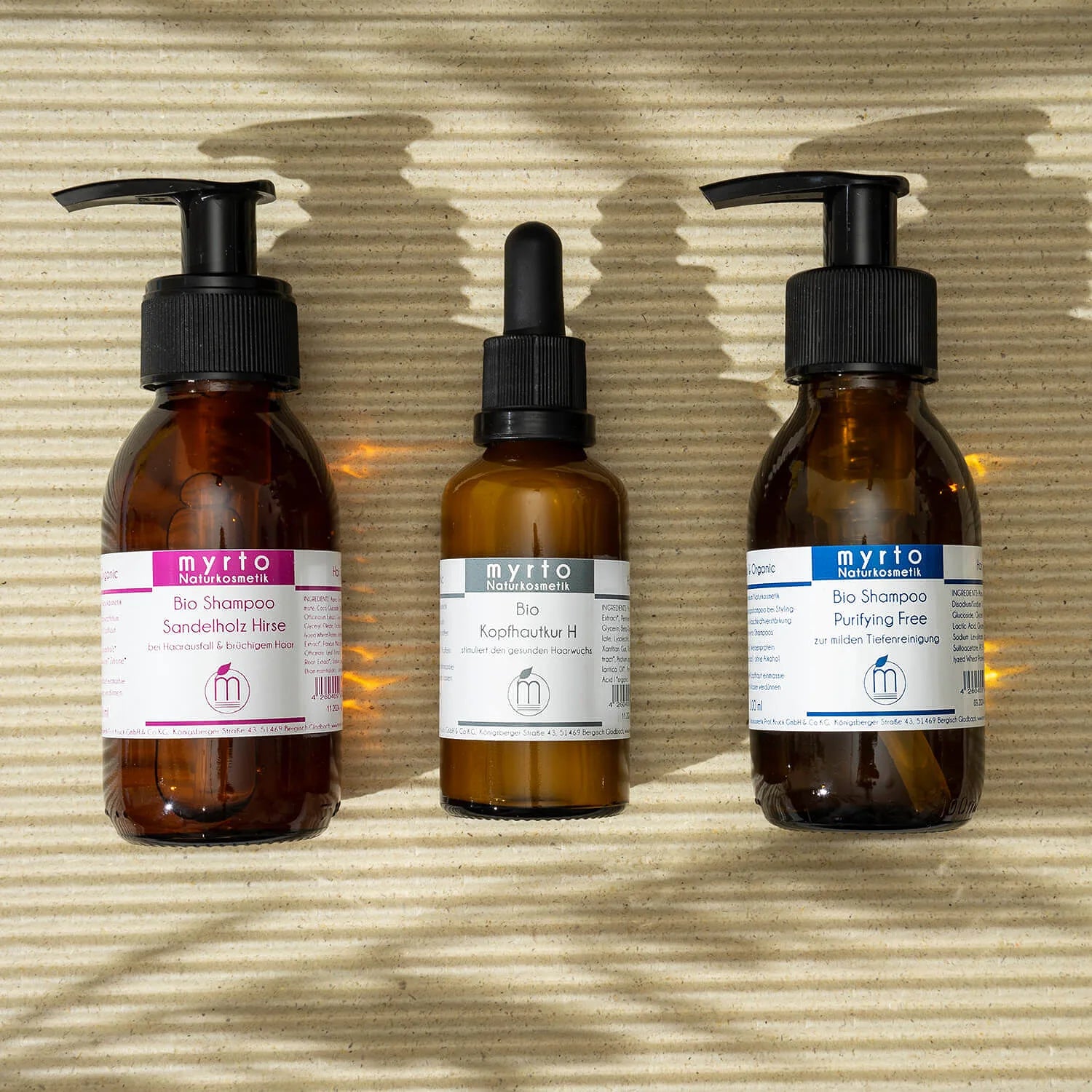Filters
Hair loss - causes and remedies for hair loss
Natural relief for hair loss – with millet extract, caffeine, and burdock root. myrto organic care strengthens hair roots, stimulates growth, and gently balances your scalp – completely free of alcohol, fragrances, or silicones.
Preventing and treating hair loss: causes and effective solutions for full hair
Hair loss affects approximately 80% of men and 40% of women at some point in their lives. This challenge can have a significant impact on self-confidence and well-being, as full, healthy hair is often considered a reflection of health and attractiveness. Excessive hair loss—more than 100 hairs lost daily over a prolonged period—disrupts the balance between hair growth and hair loss, and the hair becomes increasingly thinner. Fortunately, however, there are numerous natural and medical options to prevent hair loss and promote healthy hair growth.
Possible causes of hair loss
1. Genetic predisposition
Hereditary hair loss, also known as androgenetic alopecia, often begins in young adulthood. A genetically determined, elevated level of the hormone dihydrotestosterone (DHT) shortens the hair growth cycle, leading to thinning hair and shrinking hair follicles. In men, this often manifests as receding hairlines and bald patches at the back of the head; in women, hair thins all over the top of the head. Hereditary hair loss can be counteracted with certain treatments to slow its progression and promote hair growth.
2. Hormonal fluctuations
Women are particularly susceptible to diffuse hair loss during periods of hormonal changes such as after stopping the contraceptive pill, during pregnancy, breastfeeding and during menopause.
3. External influences and stress
Environmental toxins or pollutants in the home, as well as chronic stress, can impair hair health. Effective stress management with exercise, relaxation techniques, and sufficient sleep supports hair growth.
4. Nutrient deficiency
An unbalanced diet often leads to a deficiency in important micronutrients that hair needs. A protein-rich diet and an adequate supply of trace elements such as iron, zinc, vitamins C and A, biotin, and vitamin D promote strong hair growth.
5. Medications
Some medications such as blood thinners, beta-blockers, antidepressants and hormonal medications can cause hair loss as a side effect.
6. Inappropriate hair care
Aggressive hair care products such as shampoos with harsh surfactants (e.g. sodium lauryl sulfate) as well as chemical treatments such as dyeing or perming attack the hair roots and can lead to hair loss.
Medical treatments for hair loss
Drugs such as finasteride or minoxidil are used for the medical treatment of hair loss. Finasteride inhibits testosterone but can cause side effects such as erectile dysfunction. Minoxidil is applied topically but also has side effects, including a dry and itchy scalp and rapid heartbeat. For alopecia areata, cortisone creams or injections are used, which can also have systemic side effects.
Natural active ingredients for strong and healthy hair
1. Millet extract (miliacin) for strengthened hair roots
Millet is rich in micronutrients and, thanks to the ingredient miliacin, supports cell growth in the hair roots. Regular use of millet extract strengthens hair follicles and promotes hair growth.
2. Caffeine for improved blood circulation
Caffeine stimulates scalp circulation and prolongs the growth phase of hair follicles, thus reducing hair loss. It inhibits the conversion of testosterone to DHT, thus counteracting hereditary hair loss.
3. Burdock root extract for better hair quality
Burdock root extract regulates sebum production and strengthens the hair roots. The oleanolic acid it contains promotes cell proliferation in the hair matrix and ensures stronger hair.
Recommended products for preventing hair loss
-
myrto Organic Scalp Serum H
The myrto Scalp Serum H contains millet extract, caffeine, burdock root, sandalwood, rosemary, and cedar oil, which provide the hair roots with essential nutrients. The hypoallergenic formula supports hair growth and strengthens hair naturally, without alcohol, fragrances, or emulsifiers. -
myrto Sandalwood Millet Organic Shampoo
The gentle Sandalwood Millet Organic Shampoo from myrto is suitable for daily use and strengthens hair from the roots. Its foundation is made up of skin-friendly, cleansing amino acids that nourish the hair and scalp. Combined with the Scalp Serum H, this shampoo is ideal for building long-lasting, strong, healthy hair.
Instructions for use
Patience is crucial—hair only grows about 1 cm per month. Therefore, initial results will only be seen after at least three months of consistent use.
Michelle's experience report
" After three months of use, I see a noticeable effect. Hair loss has decreased significantly, and many baby hairs are growing back in bald spots. My sensitive scalp has calmed down, and the serum lasts a very long time. "
Conclusion
In summary, targeted, nutrient-rich care and the right product selection can effectively prevent hair loss and strengthen hair growth.
❓ Frequently asked questions about hair loss
What phases are there in the natural hair cycle?
To understand how hair loss occurs, it's important to understand the normal hair growth cycle. Each individual hair has its own growth cycle, independent of any other hair. This means that some of our hair is in the process of growth, while others are in a resting phase or will eventually fall out and be replaced.
- The growth phase (anagen phase) lasts approximately 4 - 6 years and contains 80 to 90% of all hair.
- The transition phase (catagen phase): Cell division in the hair root temporarily stops, causing the hair to stop growing and detach from the root. Approximately 1% of all hairs are in this phase. 1-3% of all hair follicles on the scalp are in this phase, which lasts approximately two weeks. The hair root becomes increasingly keratinized before transitioning into the telogen phase, which ends with hair loss.
- The resting phase/shedding phase (telogen phase) lasts approximately 4-6 months. Due to increased UV radiation in the summer months, this phase occurs more frequently in late summer and fall. The metabolic activity of the hair follicle is reduced, causing the hair to become increasingly deprived of nutrients and ultimately shed as a new hair grows. Approximately 8-14% of all scalp hairs are in this phase for approximately 3 months. The hair cycle then returns to the growth phase to begin anew.



